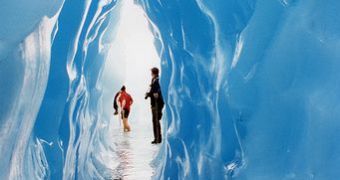Scientists discovered that a small marine filter-feeder, that anchors itself to the sea bed, brought new elements to the study of the stability of the West Antarctic Ice Sheet.
The WAIS is a very vulnerable area, and it could collapse in the future, so scientists from the British Antarctic Survey are looking for anything that could tell them more about the history of the ice sheet.
In a study for the Census of Antarctic Marine Life (CAML), they analyzed sea bed colonies of bryozoans from coastal and deep sea regions around the continent and even from further away.
What amazed them was that they found striking similarities between a species of bryozoans living on the continental shelves of the Ross Sea, and another one within the Weddell Sea.
As the distance between the two is rather important – 1,500 miles apart, and there is the West Antarctic Ice Sheet in the way, the only plausible explanation is that, at some point, there was a passage way that allowed the bryozoans to move from one sea to another.
Lead author of the paper Dr David Barnes of British Antarctic Survey explains: “When we found groups of strikingly similar bryozoans hundreds of miles apart we knew we were onto something very interesting.
He adds that because “the larvae of these animals sink and this stage of their life is short – and the adult form anchors itself to the seabed – it's very unlikely that they would have dispersed the long distances carried by ocean currents.
“Our conclusion is that the colonization of both these regions is a signal that both seas were connected by a trans-Antarctic seaway in the recent past.”
This discovery seems unreal if we think that currently, the layer of ice is 2km thick, but the scientists say that during a recent interglacial period, maybe some 125,000 years ago, when the sea level was 5 meters higher than today, a seaway opened up.
According to them, this was what allowed the bryozoans to move between the Ross Sea and the Weddell Sea.
“Our new research provides compelling evidence that a seaway stretching across West Antarctica could have opened up only if the ice sheet had collapsed in the past,” said Dr Barnes.
Geological evidence implies that the WAIS collapsed at least once in the last million years, but scientists want to know the frequency of collapse and also to better understand the connections between warm periods and deglaciation events.
In other Antarctic areas, there probably were marine animals that could have helped researchers estimate when did the west side of the continent was ice free, but advancing glaciers during ice ages carried their fossils off the continental shelf.
After recent data, scientists estimated that if the WAIS was ever to completely collapse, then the global sea level would rise by 3.3 to 5 meters.
Dr Barnes said that “the West Antarctic Ice Sheet can be considered the Achilles heel of Antarctica and because any collapse will have implications for future sea level rise it's important that scientists get a better understanding of big deglaciation events.”
This discovery is published in the current edition of the journal Global Change Biology.

 14 DAY TRIAL //
14 DAY TRIAL //